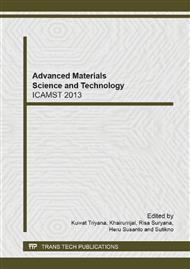p.582
p.586
p.591
p.596
p.600
p.605
p.609
p.613
p.617
Study of Laser Cladding of Stellite 6 on Nickel Superalloy Substrate with Two Different Energy Inputs
Abstract:
Stellite 6 was deposited by laser cladding on a nickel superalloy substrate (NIS) with energy inputs of 1 kW (NIS 1) and 1.8 kW (NIS 1.8). The chemical compositions and microstructures of these coatings were characterized by atomic absorption spectroscopy, optical microscopy and scanning electron microscopy. The microhardness of the coatings was measured and the wear mechanism of the coatings was examined using a pin-on-plate (reciprocating) wear testing machine. The results showed less cracking and pore development for Stellite 6 coatings applied to the nickel superalloy substrate with the lower heat input (NIS 1). Further, the Stellite coating for NIS 1 was significantly harder than that obtained for NIS 1.8. The wear test results showed that the weight loss for NIS 1 was much lower than for NIS 1.8. It is concluded that the lower hardness of the coating for NIS 1.8, together with the softer underlying substrate structure, markedly reduced the wear resistance of the Stellite 6 coating.
Info:
Periodical:
Pages:
600-604
Citation:
Online since:
February 2014
Authors:
Keywords:
Price:
Сopyright:
© 2014 Trans Tech Publications Ltd. All Rights Reserved
Share:
Citation:


